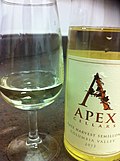Late harvest wine
Late Harvest Wine is a term used in the wine industry to describe a type of dessert wine that is made from grapes left on the vine longer than usual. The extended ripening period allows the grapes to develop higher sugar levels, which results in a sweeter wine. Late harvest wines are often rich, complex, and high in both sugar and alcohol content.
History[edit]
The practice of making late harvest wine dates back to ancient times. The Romans were known to make a sweet wine called Passum, which was made from grapes that were left on the vine to shrivel and concentrate their sugars. This tradition continued in the Middle Ages, when monks in Germany and France began making late harvest wines as a way to use grapes that were not suitable for regular wine production.
Production[edit]
Late harvest wines are made by leaving the grapes on the vine until they reach a high level of ripeness. This can be achieved through several methods, including noble rot, freeze concentration, and raisining. Each method results in a different style of wine, with varying levels of sweetness, acidity, and complexity.
Styles[edit]
There are several styles of late harvest wine, each with its own unique characteristics. These include:
- Sauternes: A sweet white wine from the Bordeaux region of France, made primarily from Sémillon grapes affected by noble rot.
- Tokaji: A sweet white wine from Hungary, made from grapes affected by noble rot. Tokaji is known for its high acidity, which balances the sweetness of the wine.
- Ice wine: A type of late harvest wine made from grapes that have been frozen while still on the vine. Ice wine is known for its intense sweetness and concentrated flavors.
- Vin Santo: A sweet wine from Italy, made from grapes that have been dried to concentrate their sugars.
Pairing[edit]
Late harvest wines are often served with dessert, but they can also be paired with cheese, foie gras, and spicy food. The high sugar content of the wine can balance the richness of the food, while the acidity can cut through the fat and cleanse the palate.
See also[edit]
-
Late harvest Semillon grapes
-
Botrytis affected Riesling grapes
-
Tokaj wine cellar
-
Ice wine grapes
Ad. Transform your life with W8MD's Budget GLP-1 injections from $49.99


W8MD offers a medical weight loss program to lose weight in Philadelphia. Our physician-supervised medical weight loss provides:
- Weight loss injections in NYC (generic and brand names):
- Zepbound / Mounjaro, Wegovy / Ozempic, Saxenda
- Most insurances accepted or discounted self-pay rates. We will obtain insurance prior authorizations if needed.
- Generic GLP1 weight loss injections from $49.99 for the starting dose of Semaglutide and $65.00 for Tirzepatide.
- Also offer prescription weight loss medications including Phentermine, Qsymia, Diethylpropion, Contrave etc.
NYC weight loss doctor appointmentsNYC weight loss doctor appointments
Start your NYC weight loss journey today at our NYC medical weight loss and Philadelphia medical weight loss clinics.
- Call 718-946-5500 to lose weight in NYC or for medical weight loss in Philadelphia 215-676-2334.
- Tags:NYC medical weight loss, Philadelphia lose weight Zepbound NYC, Budget GLP1 weight loss injections, Wegovy Philadelphia, Wegovy NYC, Philadelphia medical weight loss, Brookly weight loss and Wegovy NYC
|
WikiMD's Wellness Encyclopedia |
| Let Food Be Thy Medicine Medicine Thy Food - Hippocrates |
Medical Disclaimer: WikiMD is not a substitute for professional medical advice. The information on WikiMD is provided as an information resource only, may be incorrect, outdated or misleading, and is not to be used or relied on for any diagnostic or treatment purposes. Please consult your health care provider before making any healthcare decisions or for guidance about a specific medical condition. WikiMD expressly disclaims responsibility, and shall have no liability, for any damages, loss, injury, or liability whatsoever suffered as a result of your reliance on the information contained in this site. By visiting this site you agree to the foregoing terms and conditions, which may from time to time be changed or supplemented by WikiMD. If you do not agree to the foregoing terms and conditions, you should not enter or use this site. See full disclaimer.
Credits:Most images are courtesy of Wikimedia commons, and templates, categories Wikipedia, licensed under CC BY SA or similar.
Translate this page: - East Asian
中文,
日本,
한국어,
South Asian
हिन्दी,
தமிழ்,
తెలుగు,
Urdu,
ಕನ್ನಡ,
Southeast Asian
Indonesian,
Vietnamese,
Thai,
မြန်မာဘာသာ,
বাংলা
European
español,
Deutsch,
français,
Greek,
português do Brasil,
polski,
română,
русский,
Nederlands,
norsk,
svenska,
suomi,
Italian
Middle Eastern & African
عربى,
Turkish,
Persian,
Hebrew,
Afrikaans,
isiZulu,
Kiswahili,
Other
Bulgarian,
Hungarian,
Czech,
Swedish,
മലയാളം,
मराठी,
ਪੰਜਾਬੀ,
ગુજરાતી,
Portuguese,
Ukrainian




